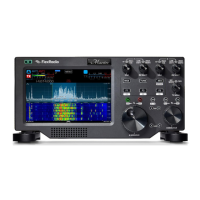FLEX-6000 Signature Series – Maestro User Guide
Copyright 2024 FlexRadio, Inc. All Rights Reserved. | Page 144
The preamplifier has protection circuitry to prevent damage above levels of +10dBm. This
protection circuitry will distort received signals if the level exceeds 10dBm. For this reason, pre-
amplification should not be used when the input signal level meets or exceeds +10dBm. When
performing all testing of a full duplex configuration, it is highly recommended that the preamplifier
be disengaged until it can be determined that the power level from the transmitter will not reach
+10dBm in any operating scenario.
32.4.3 High-Performance Analog to Digital Converter Block (ADC)
The ADC block, or digitizer, converts the received signals into digital data. All ADCs have overload
points and damage points, but there is some variability in overload symptoms. With the FLEX-6000
Signature Series radios, the ADC overload point varies from +7dBm (FLEX-6300) to +9dBm (FLEX-
6500 and FLEX-6700). This overload point is a “soft overload” meaning that at this point the
receiver will begin to show a performance drop. The ADC generally functions better with increasing
signal levels up to this point. At the soft overload point, the receiver will begin to develop spurs
that will appear in the Panadapter, and these spurs will grow as power is increased. A digital
overload point will be reached around +12dBm, but varying by the receiver, at which point the
receiver will cease to function normally, producing substantial distortion in received signals and
rendering reception difficult.
At levels above +15dBm, the ADC can be damaged so the FLEX-6000 contains circuitry to disengage
the ADC from the SCU. While circuitry should protect the radio from a damaging signal, it is highly
recommended that station configuration be designed such that signal levels above the soft
overload point are prevented from entering the antenna connector of the radio. FlexRadio
assumes no responsibility for damage incurred from high signal levels entering the receiver.
32.5 FULL DUPLEX ANTENNA ISOLATION REQUIREMENTS
For successful FDX operation, it is essential to understand and plan for sufficient transmit-to-
receive antenna isolation to prevent receiver overload and/or damage. The FLEX-6000 FDX Power
Calculation Worksheet can aid in the calculation of antenna isolation and power levels that are
suitable for a specific station.
The FLEX-6000 Signature Series transceivers are designed to disconnect the receiver from the
antenna when signal levels are +18 dBm to +22 dBm depending on frequency. The front-end
protection circuits will begin to engage at approximately +15 dBm. Front-end overload of the SCU
will occur with a single tone in the range of +8 dBm with the preamp-off. Increasing preamp gain
will lower the overload point by the amount of the added gain.
To provide suitable headroom to prevent SCU overload, we recommend that transmit-to-received
signal strength be limited to a worst-case of -20 dBm or lower at the antenna input. With 20 dB of
preamp gain, this would provide a single tone input of 0 dBm to the A/D converter leaving about 8
dB of headroom. More isolation is better.
One of the best resources for information on achieving antenna isolation is:
"Managing Interstation Interference, Revised Second Edition" by George Cutsogeorge, W2VJN.

